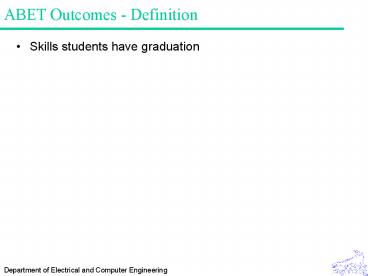ABET Outcomes Definition - PowerPoint PPT Presentation
1 / 17
Title:
ABET Outcomes Definition
Description:
EE1 - knowledge of probability and statistics, including applications ... Power Supply, Multimeter, Oscilloscope, Soldering Iron ... – PowerPoint PPT presentation
Number of Views:87
Avg rating:3.0/5.0
Title: ABET Outcomes Definition
1
ABET Outcomes - Definition
- Skills students have graduation
2
BSEE Outcomes
- EE1 - knowledge of probability and statistics,
including applications - EE2 - knowledge of mathematics, basic and
engineering sciences necessary to analyze and
design complex systems - EE3 - knowledge of advanced mathematics including
linear algebra, complex variables and discrete
mathematics - a - an ability to apply knowledge of mathematics,
science, and engineering - b - an ability to design and conduct experiments,
as well as to analyze and interpret data - c - an ability to design a system, component, or
process to meet desired needs - d - an ability to function on multi-disciplinary
teams - e - an ability to identify, formulate, and solve
engineering problems - f - an understanding of professional and ethical
responsibility - g - an ability to communicate effectively
- h - the broad education necessary to understand
the impact of engineering solutions in a global
and societal context - i - a recognition of the need for, and an ability
to engage in life-long learning - j - a knowledge of contemporary issues
- k - an ability to use the techniques, skills, and
modern engineering tools necessary for
engineering practice
3
ABET Processes - Objectives
- Course Committees are key
- Faculty Review Data, Set Standards, Control
Content
4
Issues
- Math Skills
- Retention / Recruitment
- Senior Design Overload
5
Math Preparation - Outcome a
- Assessment has indicated problems in 3111 / 3135
- Fall 2005 Spring 2006
- Average achieve Average achieve
- 3111C 3.12 85 3.06 93
- 3135 3.31 92 3.2 91
- 3472 3.27 92 3.47 92
- Lowest evaluation in the curriculum
- Reorganize curriculum
- Drop EGM 4351
- Restructure 3135 and 3112
6
3105 - Analytic Methods in EE
- 3 credits
- Application of calculus to develop the analytical
tools used in electrical engineering. Real and
complex functions and polynomials linear spaces,
linear transformations, matrices, eigenvalue
problem linear differential operators
approximation, including least squares,
interpolation, and approximation by polynomials. - Coreq - Differential Equations, 3135
- Offered first in Fall 2006
7
3135 Intro to Signals and Systems
- 3 credits
- Continuous-time and discrete-time signal analysis
including Fourier series and transforms
sampling continuous-time and discrete-time
linear system analysis with emphasis on FIR and
IIR systems impulse response, frequency
response, and system function. - Coreq - Differential Equations, 3105
8
3112 Circuits, Systems, and Signals
- 4 credits
- Continuous-time signals and linear systems
Fourier series and transforms, frequency
response, Laplace transform and system function,
analog filters emphasis on electrical circuits.
Sampling. Discrete-time signals and systems
time- and frequency-domain analysis sampled-data
systems and design of digital filters. - Prereq - 3105, 3135
9
Number of Students
- Undergrad enrollment in decline (more later)
10
Retention - Seminar Course
- Freshmen/Sophomore Seminar course
- 2 credits
- Professional Issues
- Career Building
- Sub-areas of ECE / Curriculum Options
- What is Engineering / Design
- Ethics
- IEEE Code
- Case Study Discussion
- Practical Training
- Soldering / Kit Building / Debuggin
- Software Introduction - Cluster / Matlab / Spice
- Taught Fall 2005
11
Results from Seminar Course
- Likelihood of majoring in ECE
- 1 - unlikely, 5 - very likely
- 77 very likely
- More or less likely to major in ECE after the
course?
12
ECE Adventures Course Description
- ECE Adventures is intended for freshmen and
sophomores unsure of their major or those who
would like to learn about potential experiences
of an Electrical and Computer Engineering
student. - Students learn about robots and experiment with
sensors and actuators. This process will help
them discover many basic ECE concepts. - Fall 2006 (first semester) 23 students
- Spring 2007 45 students (max space available)
13
Student Exposure
- Student used the following equipment in lab
- Power Supply, Multimeter, Oscilloscope, Soldering
Iron - Students used the following components in lab
- Protoboards, Batteries, Resistors, LEDs, switches
- IR sensors, CdS cells (photo-resistors), sonar
(ultrasound), LCD display panel - Servos, motors
- We had demonstration using the following
additional equipment - LSA, Function Generator
14
Student Accomplishments
- Students constructed circuits
- Programmed microcontrollers
- Used electronic test equipment
- Learned a little about most of the ECE
disciplines - Worked in teams (including an end-of-semester
competition) and gave a final presentation in
class - Team pictures below from final presentation
15
Results from ECE Adventures
- Likelihood of majoring in ECE
- 1 - unlikely, 5 - very likely
- 55 very likely
- More or less likely to major in ECE after the
course?
16
Senior Design
- Critical for ABET - monitor nearly all outcomes
in senior design - Lot to cover and include
- All Peer Schools use two-semester sequence
- Similar size schools break sequence
17
Junior Design
- New course for spring 2007
- Cover much of the background
- Scheduling / Documentation / Patent
- Sample Designs / Teamwork































